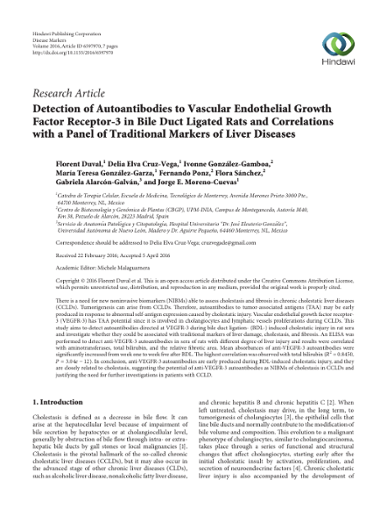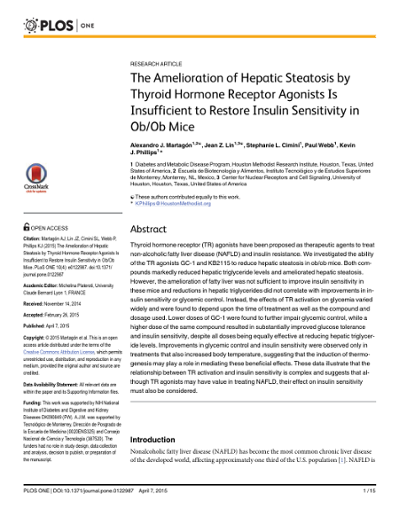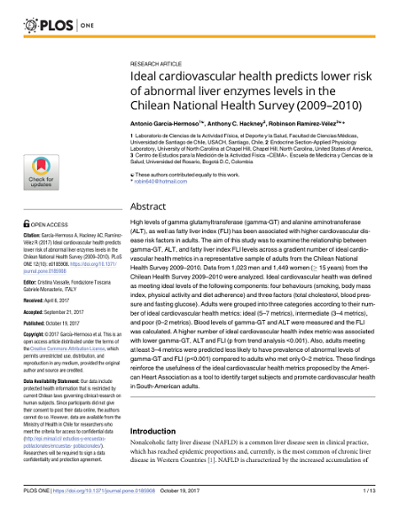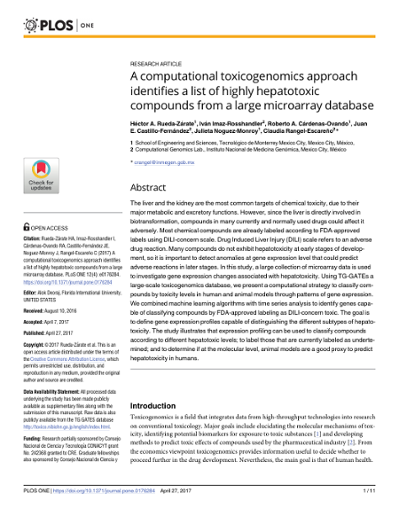| dc.creator | María Teresa González Garza y Barrón | |
| dc.creator | Jorge Eugenio Moreno Cuevas | |
| dc.date | 2016 | |
| dc.date.accessioned | 2018-10-18T15:34:07Z | |
| dc.date.available | 2018-10-18T15:34:07Z | |
| dc.identifier.issn | 2780240 | |
| dc.identifier.doi | 10.1155/2016/6597970 | |
| dc.identifier.uri | http://hdl.handle.net/11285/630267 | |
| dc.description | There is a need for new noninvasive biomarkers (NIBMs) able to assess cholestasis and fibrosis in chronic cholestatic liver diseases (CCLDs). Tumorigenesis can arise from CCLDs. Therefore, autoantibodies to tumor-associated antigens (TAA) may be early produced in response to abnormal self-antigen expression caused by cholestatic injury. Vascular endothelial growth factor receptor-3 (VEGFR-3) has TAA potential since it is involved in cholangiocytes and lymphatic vessels proliferations during CCLDs. This study aims to detect autoantibodies directed at VEGFR-3 during bile duct ligation- (BDL-) induced cholestatic injury in rat sera and investigate whether they could be associated with traditional markers of liver damage, cholestasis, and fibrosis. An ELISA was performed to detect anti-VEGFR-3 autoantibodies in sera of rats with different degree of liver injury and results were correlated with aminotransferases, total bilirubin, and the relative fibrotic area. Mean absorbances of anti-VEGFR-3 autoantibodies were significantly increased from week one to week five after BDL. The highest correlation was observed with total bilirubin (R2 = 0.8450, P = 3.04e - 12). In conclusion, anti-VEGFR-3 autoantibodies are early produced during BDL-induced cholestatic injury, and they are closely related to cholestasis, suggesting the potential of anti-VEGFR-3 autoantibodies as NIBMs of cholestasis in CCLDs and justifying the need for further investigations in patients with CCLD. Copyright © 2016 Florent Duval et al. | |
| dc.language | eng | |
| dc.publisher | Hindawi Limited | |
| dc.relation | https://www.scopus.com/inward/record.uri?eid=2-s2.0-84964703733&doi=10.1155%2f2016%2f6597970&partnerID=40&md5=448eaee8f9607d55769266e9b8dc8db3 | |
| dc.relation | Investigadores | |
| dc.relation | Estudiantes | |
| dc.rights | info:eu-repo/semantics/openAccess | |
| dc.rights.uri | http://creativecommons.org/licenses/by-nc-nd/4.0 | |
| dc.source | Disease Markers | |
| dc.subject | aminotransferase | |
| dc.subject | autoantibody | |
| dc.subject | bilirubin | |
| dc.subject | vasculotropin receptor 3 | |
| dc.subject | autoantibody | |
| dc.subject | bilirubin | |
| dc.subject | Fgfr3 protein, mouse | |
| dc.subject | fibroblast growth factor receptor 3 | |
| dc.subject | tumor antigen | |
| dc.subject | animal experiment | |
| dc.subject | animal tissue | |
| dc.subject | antibody blood level | |
| dc.subject | antibody detection | |
| dc.subject | Article | |
| dc.subject | bile duct ligation | |
| dc.subject | bilirubin blood level | |
| dc.subject | cholestasis | |
| dc.subject | controlled study | |
| dc.subject | disease marker | |
| dc.subject | enzyme linked immunosorbent assay | |
| dc.subject | liver disease | |
| dc.subject | liver fibrosis | |
| dc.subject | liver injury | |
| dc.subject | male | |
| dc.subject | nonhuman | |
| dc.subject | priority journal | |
| dc.subject | rat | |
| dc.subject | animal | |
| dc.subject | cholestasis | |
| dc.subject | disease model | |
| dc.subject | human | |
| dc.subject | immunology | |
| dc.subject | metabolism | |
| dc.subject | Wistar rat | |
| dc.subject | Animals | |
| dc.subject | Antigens, Neoplasm | |
| dc.subject | Autoantibodies | |
| dc.subject | Bilirubin | |
| dc.subject | Cholestasis | |
| dc.subject | Disease Models, Animal | |
| dc.subject | Humans | |
| dc.subject | Liver Diseases | |
| dc.subject | Male | |
| dc.subject | Rats | |
| dc.subject | Rats, Wistar | |
| dc.subject | Receptor, Fibroblast Growth Factor, Type 3 | |
| dc.subject.classification | 7 INGENIERÍA Y TECNOLOGÍA | |
| dc.title | Detection of autoantibodies to vascular endothelial growth factor Receptor-3 in bile duct ligated rats and correlations with a panel of traditional markers of liver diseases | |
| dc.type | Artículo | |
| dc.identifier.volume | 2016 | |
| refterms.dateFOA | 2018-10-18T15:34:07Z | |




